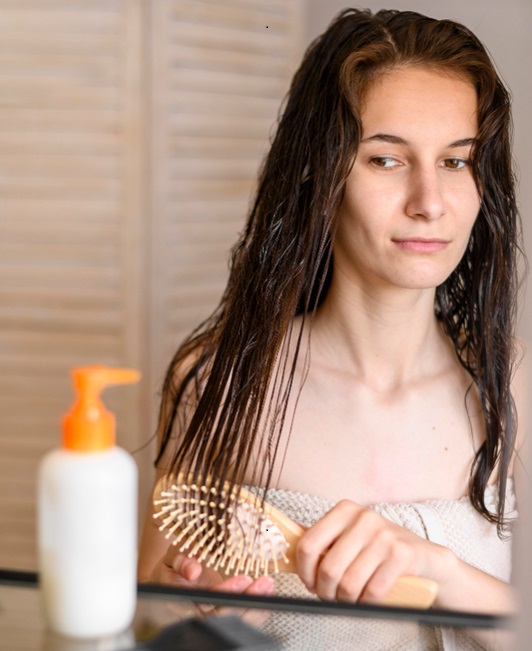Dandruff is a common scalp condition that affects millions of people worldwide. It can be both uncomfortable and embarrassing. Fortunately, dandruff-free shampoos offer an effective solution. This guide explores everything you need to know about dandruff-free shampoo, from how they work to the best ingredients to look for.
Understanding Dandruff: Causes and Symptoms
Before delving into dandruff-free shampoos, it’s important to understand what causes dandruff. The primary causes include:
- Seborrheic Dermatitis: This condition affects oily areas of the body, including the scalp. It causes red, greasy skin covered with flaky white or yellow scales.
- Malassezia Yeast: A yeast-like fungus that lives on the scalps of most adults. For some, it irritates the scalp and causes increased cell turnover, resulting in dandruff.
- Dry Skin: Dry scalp skin flakes off more easily, which can be exacerbated by cold weather and low-humidity environments.
- Skin Conditions: Conditions like psoriasis and eczema can also contribute to dandruff.
- Hygiene and Hair Care Products: Infrequent shampooing can lead to oil and skin cell buildup, while sensitivity to certain hair care products can cause scalp irritation.
Symptoms of dandruff include white flakes on the scalp, hair, and shoulders, an itchy scalp, and sometimes red or greasy patches on the scalp.
How Dandruff-Free Shampoos Work
Dandruff-free shampoos are formulated to address the underlying causes of dandruff and alleviate its symptoms. Here’s how dandruff-free shampoo works:
- Antifungal Agents: Ingredients like ketoconazole, zinc pyrithione, and selenium sulfide target and reduce the Malassezia yeast.
- Exfoliants: Salicylic acid helps to remove dead skin cells and flakes from the scalp.
- Anti-inflammatory Ingredients: Coal tar and corticosteroids can reduce inflammation and soothe the scalp.
- Moisturizers: Ingredients like aloe vera and tea tree oil help to hydrate the scalp and reduce dryness.
- Balancing Oils: Some dandruff-free shampoos contain natural oils that help to balance the scalp’s oil production.
Choosing the Right Dandruff-Free Shampoo
When choosing a dandruff-free shampoo, consider the following factors:
- Scalp Type: Your scalp type (oily, dry, or combination) will determine the best dandruff-free shampoo for you. Oily scalps may benefit from shampoos with salicylic acid, while dry scalps may need more moisturizing ingredients like aloe vera.
- Severity of Dandruff: For mild dandruff, a dandruff-free shampoo with zinc pyrithione or tea tree oil may suffice. For more severe cases, ketoconazole or selenium sulfide may be necessary.
- Frequency of Use: Some dandruff-free shampoos are strong and meant to be used only a few times a week, while others are gentle enough for daily use.
- Sensitivity: If you have sensitive skin, look for dandruff-free shampoos that are free from harsh chemicals, fragrances, and dyes.
Tips for Using Dandruff-Free Shampoos
Here are some tips for using dandruff-free shampoos:
- Follow Instructions: Always follow the instructions on the dandruff-free shampoo bottle for the best results. Overuse or improper use can cause scalp irritation.
- Consistency: Consistent use of dandruff-free shampoo is key to controlling dandruff. Stick to a regular shampooing schedule.
- Rinse Thoroughly: Make sure to rinse your hair thoroughly to remove all dandruff-free shampoo residues, which can irritate the scalp.
- Avoid Heat Styling: Heat styling tools can dry out the scalp and exacerbate dandruff. Try to limit their use.
- Complementary Products: Consider using a moisturizing conditioner or scalp treatment to complement your dandruff-free shampoo.
Home Remedies and Natural Alternatives
In addition to dandruff-free shampoos, several home remedies can help manage dandruff:
- Rosemary Oil: Rosemary oil has natural antifungal and antibacterial properties that could help address dandruff. Additionally, it may improve blood circulation on the scalp, promoting hair growth and overall scalp health.
- Ginger Oil: Its anti-inflammatory and antimicrobial properties might help with dandruff. When used in dandruff shampoo for women, it could potentially reduce scalp irritation and flakiness.
- Bamboo Vinegar: Bamboo vinegar helps balance the scalp’s pH, reduce inflammation, and promote healthy hair growth. It contains antibacterial properties that might assist in controlling dandruff-causing bacteria.
- Peppermint Oil: Peppermint oil has natural antimicrobial properties that can help to control the growth of bacteria that contribute to dandruff. Additionally, the cooling property of peppermint can provide relief from itching and irritation on the scalp.
- Vitamin C: Vitamin C is often included in dandruff treatment shampoo for its potential antioxidant and exfoliating properties. It can help promote a healthy scalp by reducing inflammation and flakiness. Additionally, Vitamin C may support collagen production, which contributes to overall scalp health.
Conclusion
Dandruff-free shampoos offer a reliable solution to the discomfort and embarrassment caused by dandruff. By understanding the causes of dandruff and choosing the right dandruff-free shampoo with effective ingredients, you can manage and reduce dandruff significantly.
